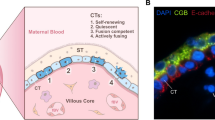Summary
In preimplantation stages of normal and spontaneously activated parthenogenetic embryos of the LT/Sv mouse strain, protein synthesis was analyzed by using two-dimensional polyacrylamide gel electrophoresis. Fertilization and parthenogenetic activation cause similar changes of polypeptide synthesis when compared with those of unfertilized eggs. The overt developmental delay of early parthenotes, which is probably due to an initial retarded activation in comparison with normal fertilization, is documented molecularly by a similar delay in their protein synthesis pattern. These differences are clearly visible at the two-cell stage but gradually disappear during further cleavage. The basic protein patterns of normal and parthenogenetic embryos are remarkably similar up to the blastocyst stage. However, quantitative differences occur in all preimplantation embryos analyzed and become more distinct at the blastocyst stage. In addition, only minor qualitative changes appear during late preimplantation. These alterations in protein synthesis may reflect at the molecular level early events in abnormal development of parthenotes. Our biochemical results are discussed in context with biological experiments rescuing parthenogenetic LT/ Sv embryos by chimera formation.
Similar content being viewed by others
References
Abreu SL, Brinster RL (1978) Synthesis of tubulin and actin during the preimplantation development of the mouse. Exp Cell Res 114:135–141
Bachvarova R, De Leon V (1980) Polyadenylated RNA of mouse ova and loss of maternal RNA in early development. Dev Biol 74:1–8
Beatty RA (1967) Parthenogenesis in vertebrates. In: Metz CB and Monroy A (eds) Fertilization vol. 1, Academic Press Inc New York, p 413
Braude PR (1979) Control of protein synthesis during blastocyst formation in the mouse. Dev Biol 68:440–452
Braude PR, Pelham H, Flach G, Lobatto R (1979) Post-transcriptional control in the early mouse embryo. Nature 282:102–105
Cullen B, Emigholz K, Monahan J (1980) The transient appearance of specific proteins in one-cell mouse embryos. Dev Biol 76:215–221
Eppig JJ, Kozak LP, Eicher EM, Stevens LC (1977) Ovarian teratomas in mice are derived from oocytes that have completed the first meiotic division. Nature 269:517–518
Graham CF (1974) The production of parthenogenetic mammalian embryos and their use in biological research. Biol Rev 49:399–422
Hoppe PC, Pitts S (1973) Fertilization in vitro and development of mouse ova. Biol Reprod 8:420–426
Howe CC, Solter D (1979) Cytoplasmic and nuclear protein synthesis in preimplantation mouse embryos. J embryol Exp Morphol 52:209–225
Illmensee K (1978) Reversion of malignancy and normalized differentiation of teratocarcinoma cells in chimeric mice. In: Russell LB (ed) Genetic Mosaics and Chimeras in Mammals. Plenum Press p 3
Johnson MH (1979) Intrinsic and extrinsic factors in preimplantation development. J Reprod Fertil 55:255–265
Laskey RA, Mills AD (1975) Quantitative film detection of 3H and 14C in polyacrylamide gels by fluorography. Eur J Biochem. 56:335–341
Levinson J, Goodfellow P, Vadeboncoeur M, McDevitt H (1978) Identification of stage-specific polypeptides synthesized during murine preimplantation development. Proc Natl Acad Sci USA 75:3332–3336
O'Farrell PH (1975) High resolution two-dimensional electrophoresis of proteins. J Biol Chem 250:4007–4021
Stevens LC, Varnum DS (1974) The development of teratomas from parthenogenetically activated ovarian mouse eggs. Dev Biol 37:369–380
Stevens LC (1975) Teratogenesis and spontaneous parthenogenesis in mice. In: Markert CL, Papaconstantinou J (eds) The Developmental Biology of Reproduction. Academic Press, Inc, New York, p 93
Stevens LC (1978) Totipotent cells of parthenogenetic origin in a chimaeric mouse. Nature 276:266–267
Whittingham DG (1971) Culture of mouse ova. J Reprod Fertil Suppl 14:7–21
Author information
Authors and Affiliations
Additional information
Communicated by K. Illmensee
Rights and permissions
About this article
Cite this article
Petzoldt, U., Hoppe, P.C. Spontaneous parthenogenesis in Mus musculus: Comparison of protein synthesis in parthenogenetic and normal preimplantation embryos. Molec. Gen. Genet. 180, 547–552 (1980). https://doi.org/10.1007/BF00268059
Received:
Issue Date:
DOI: https://doi.org/10.1007/BF00268059




